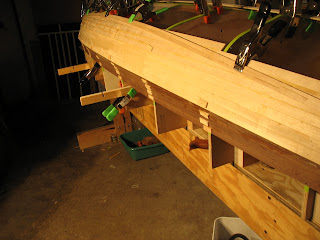
As with the walnut strips, we used a combination of nails, tape and clamped Plexi to get a good glue line.
At this point, we decided it was easier to cut the rolling bevels on the strip that was to be glued on next rather than the strip that was already in place. The next photo shows a couple of simple jigs we made to hold the strips while I planed the bevels.

The stripping proceeded rather routinely for the first 3 courses. At this point, we were able to employ another clamping aid which was simply small 2 x 3 squares of plywood with a notch cut in them so they would fit over the preceding strips. These squares were faced on one side with 80 grit sandpaper so they wouldn't slip. They were held to the station molds with a spring clamp and then tapped down with a mallet to close the gap between the strips until glue squeezed out. This method allowed us to eliminate making nail holes at each station mold.

After 8 courses of strips were glued onto both sides, we noticed that the strips were getting extremely hard to lay down at the ends because of the twist that was present
As well, we found ourselves unable to use the little clamping squares and had to resort to nails to get the strips to lie against the tight turn of the bilge.
At this time, we took a strip and bent it downward (toward the gunwales) until it fell in a fair curve without twist. We clamped it in this position at the stems and scribed a line along the top edge. Then we used my small Lie-Nielsen dovetail saw (which is actually a sweet little rip saw) to cut close to the line. Once again, we planed it down to the line with the shoulder plane. The next several strips now fell easily against the station molds without excessive twist--that is, until we got past the turn of the bilge and started stripping out the bottom.

Here is a shot of the cut we made to accommodate easier planking.
End view of our ingenious little clamping blocks. We soon found out that they only worked where there was enough room to fit them over the previous stripping. As we approached the keel, we had to abandon them again and go back to nailing.

The last several strips had quite a bit of twist in them, so much that we broke one pulling it down and had to replace it. Some rather novel methods were needed to get these strips to lay down fair against the stems.

After several days of 4 - 6 strips per evening, we finally arrived at the point where we would begin to close the bottom of the hull. This was one of the easiest and most enjoyable parts of the stripping operation.

First of all, the strips on the center bottom of the hull have very little twist and lie flat across the station molds. We were able to put these strips on with only a very slight bevel at certain station molds. Not only that, the strips got progressively shorter and took a lot less time to fit.
After the keel line was entirely covered with stripping, we ran a length of bright yellow Dacron fly reel backing down the exact centerline and used it to strike a perfectly straight line precisely along the keel line. After that, I chiseled out the excess with the 2" chisel and finished with the shoulder plane.

Here is a shot of the straight run along the keel line and the space left for the closing strip. At long last, we were ready to close the hull!
This last strip, which had to fit perfectly, took almost an hour for me to fit.

We used lengths of the green masking tape to pull the sides together in a dry run of the gluing. When we were sure it would close properly, we put the glue on and slipped it into place on the bottom.

Here is the closing strip, all glued in. We got plenty of glue squeeze out so we knew we had it firmly in place.

Here's a parting shot of the hull, all cleats and tape removed and lightly wet with a sponge to get an idea of what she'll look like when under varnish.






































